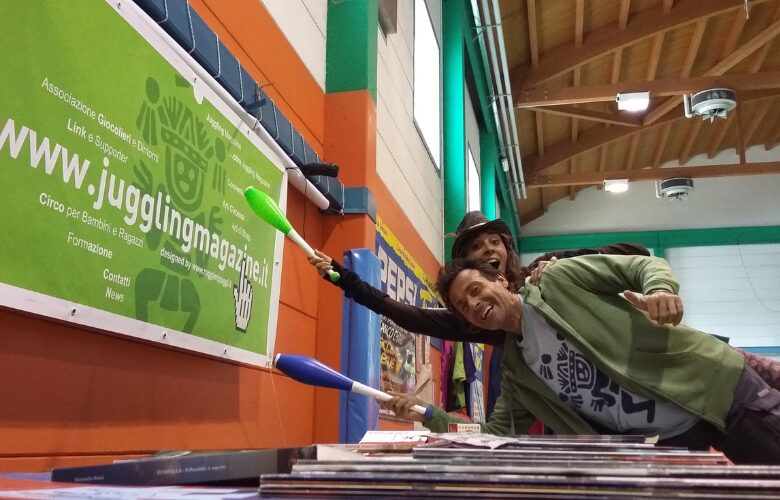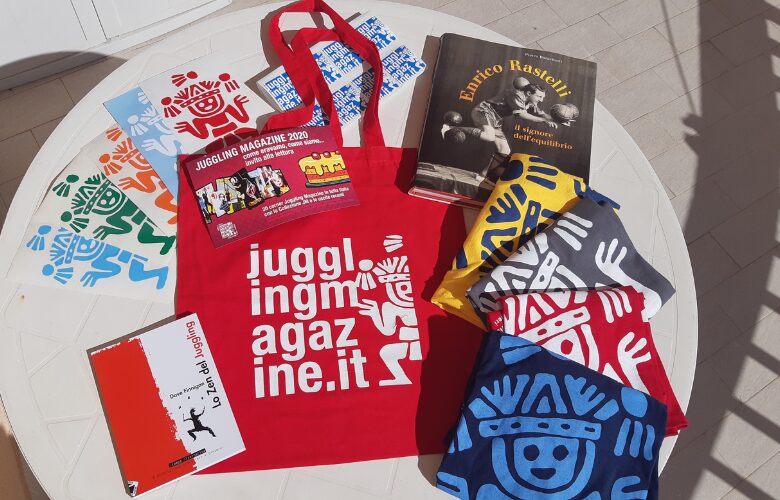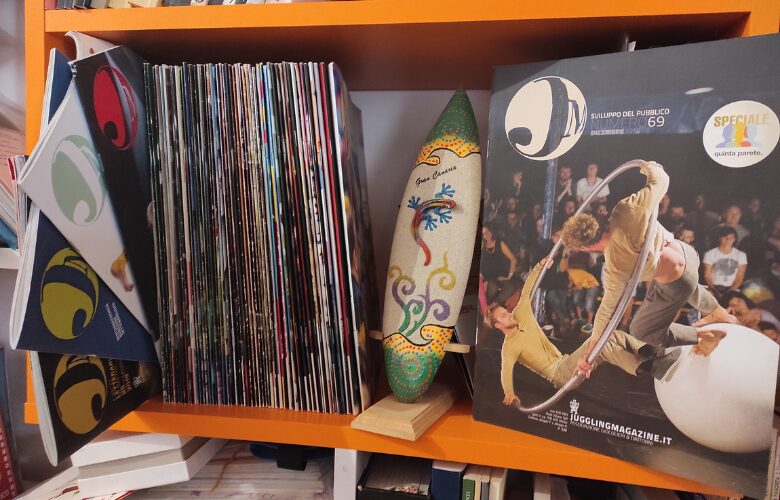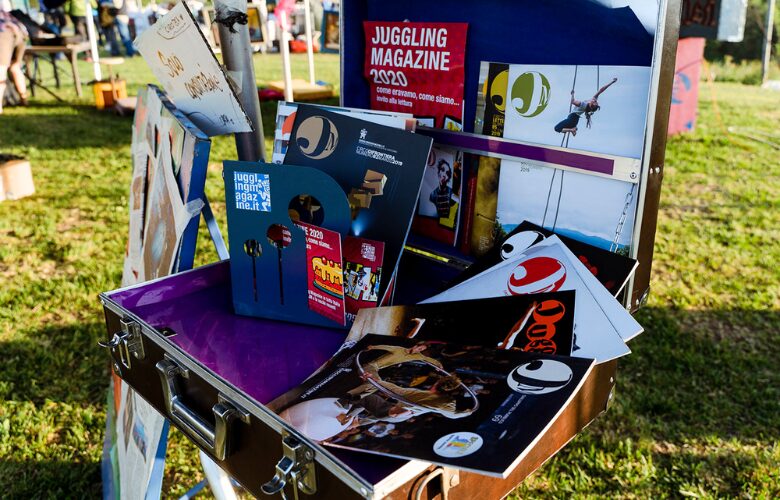Journey of Passion – The Story Behind Juggling Magazine

For over two and a half decades, Juggling Magazine has been a cornerstone of the circus and outdoor arts in Italy, connecting artists, trainers, and enthusiasts through authentic storytelling and community-building. Founded by Adolfo Rossomando, the magazine has grown from a niche publication into a dynamic platform that reflects the evolution of contemporary circus in Italy and beyond.
I had the privilege of sitting down with Adolfo, just a year after the magazine’s 25th anniversary. Adolfo is a driving force in contemporary circus —someone everyone seems to know and deeply respect. Yet, despite his achievements, he remains remarkably humble and never one to seek the spotlight. Talking with him felt truly special, as it is rare to hear him speak so openly about his journey and the driving passion behind Juggling Magazine.
In our conversation, Adolfo shares insights into the magazine’s humble beginnings, its transition into the digital era, and his commitment to fostering dialogue and connections within the circus arts.
Andrea Honis: What inspired you to start the magazine?

Adolfo Rossomando: Well, it has been an interesting journey. Back in the late-1980s I was living in London where, like in a fairy tale, I met three joyful and young communities that would fill most of my life & soul: spray can artists, jugglers, kite flyers. Learning my first juggling trick, chasing spray can masterpieces and artists along the “Tube”, or joining kite festivals were filling my spare time.
Back to Italy I started working at Alivola, an Italian kite manufacturer, and collaborating with Stampa Alternativa, a counterculture Italian publisher. At the time, stunt kites and one-line artistic kites were a big trend, with festivals around the world showcasing their beauty and the unique talents driving them. Interestingly, kite shops often sold juggling equipment alongside kites. With EJA landing in Torino in 1997 and juggling start spreading in Italy too, the kite manufacturing company began distributing also juggling equipment. The demand for more information and tutorials about juggling was big. At the time, I had already authored two successful pocket guides on learning kite flying and 3-ball juggling. My expertise as an author prompted Alivola to produce a magazine to promote juggling, with me as the managing editor. In a short span, the inaugural “number zero” issue of Juggling Magazine was ready for nationwide distribution and was presented in 1998 at both the European Juggling Convention in Edinburgh and the first Italian Juggling Convention in San Giovanni in Persiceto (BO).
AH: Was the magazine independent from the start?
AR: Not initially. The first, “number zero” issue was entirely supported by Alivola kite manufacturer and included promotional content for their products. However, three months later life had already offered me new opportunities, including a fulltime job in the publishing house Stampa Alternativa and a precious collaboration with Holistic Center Albero della Vita.
I brought the Juggling Magazine project with me, and for the next three years the publishing house would produce it, with the side support of the holistic center. These partnerships allowed for a broader distribution network and added value. A series of books dealing with juggling and contemporary circus, a training program for youth circus trainers and producing juggling events, were the first side projects of Juggling Magazine.
Although the books and training courses were highly successful and gained traction, Juggling Magazine remained a small niche project compared to the rapidly growing and larger commercial and cultural initiatives of the publishing house and the holistic center. As the field of juggling and contemporary circus rapidly evolved, I realized that Juggling Magazine needed a stronger foundation and more focused support. My extensive experience in sales and marketing had also broadened my expertise in publishing. One potential route was seeking support from the Ministry of Culture. In 2002, I took a pivotal step by founding the cultural association Giocolieri e Dintorni and applying for funding. Our project was successfully funded, enabling us to transition the magazine into a fully independent publication with financial backing secured through institutions, sponsors, and subscribers.
AH: You have had quite a journey with the magazine. Can you share how your content and editorial focus evolved throughout these years?
AR: Initially, the focus was primarily on juggling and street art, but over time it expanded to include contemporary circus and outdoor arts. By 2006-2007 it had become the balanced mix you can still see today. We also dedicated significant space to youth circus and social circus initiatives, which we were strongly supporting in Italy. In addition to the main project, Juggling Magazine, we quickly developed two other key initiatives: Circosfera (circosfera.it), focusing on the development of youth circus in Italy, and AltroCirco (altrocirco.it), dedicated to the growth of social circus in Italy. In 2015, we launched Progetto Quinta Parete, a major new project centered on audience development and engagement. These initiatives evolved alongside the magazine, reflecting the broader growth of our umbrella organization and the circus arts in Italy. Nevertheless, since the beginning, Juggling Magazine has had a very clear editorial policy: it’s not meant to be a magazine written and read by academics or critics, even though we host critic or academic contents every now and then. Instead, the focus has always been on accessibility and relatability. The goal is to give people—artists, professionals, and others in the field—a platform to speak directly about their experiences, but keeping the discourse accessible also to readers who are approaching contemporary circus for the first time, or readers who have no academic background. Accessibility remains the core purpose of the magazine.
AH: How did the landscape of juggling and circus journalism look at the end of the 1990s compared to the digital era we live in now?
AR: At the time, there were two prominent juggling magazines— Catch from the UK and Kaskade from Germany. They served as my models. I admired Catch for its British humor and Kaskade for its focus. I didn’t know much about circus back then. My passion for circus grew gradually through interviews and interactions with circus artists and historians.
The early days of the magazine were very different from today. With no internet, social media, or smartphones, the magazine served as a crucial connection point for the community. With fewer content sources available, each publication and article carried a much greater impact.
With digital media the landscape has completely shifted, for good. While pri
nt still has its “charm,” digital content allows us to share more multimedia formats, reach a much wider audience, and engage readers more effectively.
AH: Speaking of digital media, how has Juggling Magazine adapted to the digital era?

AR: While the print magazine remains our core, we’ve explored ways to engage readers across different media formats. The challenge is maintaining the depth and soul of our journalism while adapting to faster-paced digital communication. Over the past two decades, alongside the printed magazine and numerous main projects, we have successfully managed five websites, three newsletters, a dozen social media channels, and a resource center hosting all our publications online. However, our greatest challenge has been, and continues to be, producing video content. Video is an essential medium for promoting and sharing circus arts. We began producing VHS recordings of the Italian Juggling Convention in the late ’90s and launched an online video magazine in 2011. Unfortunately, we discontinued the video magazine due to the high resource demands of creating high-quality video content. In the meantime, we’ve been incorporating QR codes into the pages of Juggling Magazine, linking readers to online videos.
AH: You mentioned earlier that the impact of magazines and written articles used to be much greater than it is today. In a world where content is everywhere, and quality often takes a backseat to quantity, what do you see as the purpose of good performing arts journalism today?
AR: Even though there’s so much amatorial work out there on the web, there’s still a lot of great writing — much more than ever before. And with greater access to good writing, this is actually an exciting time, far from a “Middle Age” of content. Of course, as a reader, you have to select your sources, especially if you’re looking for deeper insights and good quality journalism. The purpose of good performing art journalism should serve the quest for filling the gap between artists and audience, players and institutions. A bridge which better connects everybody with the deep power of performing arts; a golden key which opens doors to a world of opportunities. Good journalism is, like any good writing, meant to reveal meanings we haven’t reached yet.
AH: The magazine is in Italian, but its content could resonate with an international audience. With the internet and globalization becoming part of our life, have you ever considered publishing the articles in English as well?
AR: That’s a question that has come up many times over the years. From the beginning and still today, the magazine is tailored specifically for the Italian scene, serving its development. We’re not directly addressing the international community, though we know that some articles have international content and appeal. Besides, and unfortunately, Italian is mainly spoken in Italy and by Italian communities abroad.
The language divide is, of course, a significant barrier that does not allow content to travel internationally. Luckily, there are many digital tools that enable quick and reliable instant translations, at least for digital content.
The difficulty of circulating content written in languages other than English, Spanish, French, or other widely spoken languages is also strongly felt within the platform for the circus arts media project founded in 2011, called INCAM (International Network of Circus Arts Media).
AH: What’s your vision for INCAM?
AR: INCAM has been a valuable network for connecting media creators in the circus world. It gathers almost 20 circus arts publication members from all over the world. The opportunity to exchange ideas and collaborate with others in the field is truly inspiring. However, running a network requires significant resources. While I founded and still keep coordinating INCAM, I really invite the new generation to enter and take this project to the next level, bring fresh energy and move it forward.

AH: How do you ensure the magazine reaches beyond the juggling community?
AR: Our content has broadened to include artistic creation, social circus, and audience development, appealing to a wide range of readers—from trainers to producers. We also distribute the magazine to youth circus schools, theaters and performing arts spaces across Italy, ensuring it reaches professionals outside the circus world. Celebrating our first 20 years in 2018, we distributed over 25 full collections of Juggling Magazine to circus schools, libraries, and cultural venues across Italy, allowing people to freely access them. We are still expanding Juggling Magazine corners.
Of course, the idea of changing the magazine’s name to better reflect the contemporary circus field we cover has lingered for some years already. Maybe one day, we will leave the christened name behind!
AH: Finally, what’s next for Juggling Magazine?
AR: The core of the magazine will remain unchanged, but we’ll continue exploring innovative ways to connect with audiences, including merging circus and kitesurfing—my two lifelong passions. We are also dedicating resources to redesigning the entire graphic layout, enhancing our social media strategy, and creating an online annotated index of content to facilitate searches through our archive of over 3,500 articles.
I have a deep gratitude for the support the magazine continues to receive. It’s heartening to see that, even in the digital age, there’s still a place for thoughtful, meaningful journalism. For me, the greatest joy of this work is the connections it fosters—with people, stories, and the artistry of the field. It’s a labor of love, daily feeding my soul, and that’s what keeps me going.
AH: Thank you for sharing your incredible journey with us, Adolfo. Your story is a beautiful testament to the idea that we don’t have to search for our purpose in life; we simply need to stay open and allow it to find us.
Main image:Juggling Magazine stall at Briazola Juggling Convention. All photos are courtesy of Adolfo Rossomando.
Editor's Note: At StageLync, an international platform for the performing arts, we celebrate the diversity of our writers' backgrounds. We recognize and support their choice to use either American or British English in their articles, respecting their individual preferences and origins. This policy allows us to embrace a wide range of linguistic expressions, enriching our content and reflecting the global nature of our community.
🎧 Join us on the StageLync Podcast for inspiring stories from the world of performing arts! Tune in to hear from the creative minds who bring magic to life, both onstage and behind the scenes. 🎙️ 👉 Listen now!


